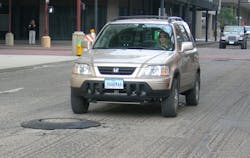Contractor protects motorists on U.S. 164
If manhole adjustment is a relatively small part of most paving projects, protecting the raised manhole—after milling and before new paving—is downright obscure.
And ideally, this protection only has to last a day or two. But in some ways, protecting the raised manhole is equivalent to protecting the cars that use the milled roadway before repaving—if a car (or construction vehicle) hits the raised, exposed manhole it can ruin the new rim and it also can do serious damage to undercarriages.
To prevent this, many contractors pack hot mix in a flat cone around the raised manholes. But this is far from a perfect solution. For one thing, it’s a tedious task and the hot mix requires trucking from an asphalt plant. And also, if the hot mix has to stay in place for very long, it may crumble and degrade, and need replacing . . . or it may cause problems before someone can get to it.
Bailey Watkins with Fred Smith Co. quickly realized the importance of protecting motorists from exposed manholes. Fred Smith Co. was working on a North Carolina DOT project—U.S. 164—when it was notified that manhole protection needed to be provided at night, after asphalt plants were closed. Watkins came up with a solution—the Manhole Safety Ramp from American Highway Products.
“I gave them to our crews, and they worked well right away—they're the correct slope and meet NCDOT requirements,” Watkins said.
On that same initial project, a long period of bad weather meant that some safety ramps had to remain in place for two weeks, in heavy rain. The safety ramps performed well even in adverse conditions. “They stayed in place, no problem,” said Watkins.
